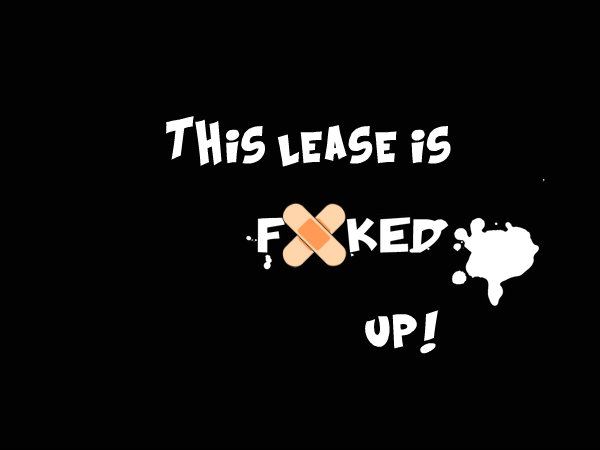F**ked wind company lease! (Maine)
Oct 11, 2013

Editor’s note: Read the passage, below, from a wind energy lease in Maine, USA. In our experience, the shocking language is pretty typical.
It’s one thing for the property owner to blithely allow the wind developer to render his property acoustically toxic—but do property owners have the right (moral or legal) to inflict this acoustic terrorism on their neighbors? (Hmm, does the offensive property owner even live there?)
After all, does the “sound generated from the Wind Power Project” and the “audio, visual, light, vibration [infrasound], electromagnetic . . . hazard resulting from the Wind Power Project” and the “right to cast . . . shadow flicker . . . onto the Property”—do these injurious forces and events somehow magically stop at the property line? As though a fictive property boundary effectively blocks and contains these noxious and dangerous by-products of “wind energy”?
Do wind turbine “hosts” have the right to inflict such injury on neighbors? Or is this a theft of “commons” rights—a theft being slyly perpetrated and encouraged by wind developers? (Consider, for a moment, what all this does to a rural community as the wind company salesman drives away with his signed lease. Neighbor hating neighbor! The soul of “community,” human habitat, sold for . . . thirty pieces of silver.)

“And Judas went out and hanged himself” (Matthew 27:5).
Whereas, the Wind Power Project may emit sound at levels that may exceed current or future Maine Department of Environmental Protection quiet nighttime sound limits for the Property, and additionally may cast shadows onto or produce a shadow flicker effect on the Property;
Now, therefore, for good and valuable consideration, the receipt and sufficiency of which are hereby acknowledged, Grantor hereby grants, with Quitclaim covenant, a perpetual easement to Grantee for: (a) the right to have sound generated from the Wind Power Project impact the Property and exceed otherwise applicable federal, state, local or other maximum sound level limits applicable to locations on the Property; (b) the right to have any audio, visual, light, vibration, electromagnetic, ice or weather hazard resulting from Wind Power Project operations or activities impact the property; and (c) the right to cast shadows or shadow flicker from the Wind Power Project onto the Property.

Comment by michael fairneny on 10/11/2013 at 12:31 pm
Wind developers also target the most affected properties (residents) and offer what THEY call “A GOOD NEIGHBOR AGREEMENT”….for a very small amount of money per year you give away your right to speak out against the project and accept this “BRIBE” to shut up….I call it a “GAG ORDER”…..and it goes on and on….and it’s considered perfectly legal….WHAT A F–KED UP WORLD !!
Comment by Tom Whitesell on 10/11/2013 at 12:36 pm
… and I, the Grantor, do hereby give permission [to the Grantee] to
steal my neighbor’s chickens, and then burn down his house.
Comment by Mike McCann on 10/11/2013 at 12:57 pm
Those are typical lease terms, parallel to terms from numerous wind companies and project locations. They are also synonymous with the Easement in Gross recorded documents for the 5 developer buyouts and resales cited in the 2012 Ben Lansink study.
So when a buyer is fully informed of these “conditions” (as they were in those 5 cases, since they had to grant back to Canadian Hydro said easements) they pay on average 39% less than the unaffected value.
However, the greatest majority of turbine-affected sales are not made with such disclosure from the seller to the buyer, and the average diminution under that “uninformed” or partially informed buyer condition is around 25%.
Thus, when there is merely the visual impact, it is around 25% lower value, but jumps to nearly 40% when a buyer is “fully informed”…(one of the prerequisites for meeting the definition of Market Value).
Visual aesthetic impacts do not need to be disclosed from a seller to a buyer, as presumably the buyer can “see” the nature of the impact. But the noise, flicker, ILFN, and/or health impacts are perhaps qualified as a “latent” defect, and should normally be disclosed if the seller is aware of such defects.
Potential sellers face the decision of disclosing whether there is a defect with their property, or whether an externally caused condition does not require disclosure. That is one of the real dilemmas for many wanting to move away. If they (or broker) informs the buyer, then their property value haircut goes to the bone, or they lose the sale entirely.
And you are exactly correct sir; the property line does not magically prevent the trespass of such impacts onto neighboring property. Neither does denial of the problem.
Comment by johana on 10/11/2013 at 1:58 pm
It’s WORSE, and I fear for the sanity of our species.
What we need is an army of psychiatrists to take the perpetrators into custody and treat them until they come to their senses.
Comment by Marshall Rosenthal on 10/11/2013 at 5:59 pm
Beware ye politicians, ye absentee wind power hosts, ye Beverly yahoos, hillbillies who would invite pie-in-the-sky scams into their towns, only later to realize the disaster they have brought on their neighbors.
I think the worm is turning, as it must, on these monsters.